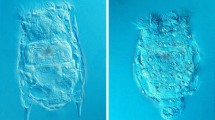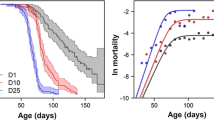Abstract
Field experiments investigated survival and development in an arctic population of the oribatid mite Ameronothrus lineatus living on cyanobacterial mats. Mites were sorted to instar and kept in microcosms for 1 year (1997–1998). Juvenile winter survival was high (56–79%), but only about 50% of the adults survived the winter. Summer survival was high in all instars (60–80%). This gave a high survival to adulthood (13.3%). A synchronized moult was observed in July, but juvenile development during the rest of the exceptionally warm summer of 1998 varied both between and within stages, with immatures moulting not at all or up to two times. In a second set of cohorts, experiencing a shorter summer, most juveniles moulted once. Thus, A. lineatus has a flexible life cycle with the juvenile stages normally lasting 1 year, giving a larva-to-larva developmental time of 5 years, but with an increased developmental rate in warm summers. Development also seemed to depend on gender, with males developing faster than females. Adult longevity was studied in the laboratory, and most of the adults lived for 2–3 years.





Similar content being viewed by others
References
Bhattacharya T, Joy VC, Joy S (1978) Studies on the effect of temperature on the development of Oppia nodosa Hammer (Acari: Cryptostigmata: Oppiidae). Entomon 3:149–155
Block W (1965) The life histories of Platynothrus peltifer (Koch 1839) and Damaeus clavipes (Hermann 1804) (Acarina: Cryptostigmata) in soils in Pennine moorland. Acarologia 7:735–743
Block W, Convey P (1995) The biology, life cycle and ecophysiology of the Antarctic mite Alaskozetes antarcticus. J Zool (Lond) 236:431–449
Bücking J, Ernst H, Siemer F (1998) Population dynamics of phytophagous mites inhabiting rocky shores—K-strategists in an extreme environment? In: Ebermann E (ed) Arthropod biology: contributions to morphology, ecology and systematics. Biosystematics and ecology series, vol 14. Verlag der Österreichischen Akademie der Wissenschaften, Vienna, pp 93–143
Convey P (1994) Growth and survival strategy of the Antarctic mite Alaskozetes antarcticus. Ecography 17:97–107
Convey P (2001) Antarctic ecosystems. In: Levin SA (ed) Encyclopedia of biodiversity, vol 1. Academic Press, San Diego, pp 171–184
Convey P, Worland M (2000) Refining the risk of freezing mortality for Antarctic terrestrial microarthropods. Cryo Letters 21:333–338
Coulson SJ, Hodkinson ID, Strathdee AT, Block W, Webb NR, Bale JS, Worland MR (1995) Thermal environments of arctic soil organisms during winter. Arct Alp Res 27:364–370
Danks HV (1981) Arctic arthropods. A review of systematics and ecology with particular reference to the North American fauna. Biological survey project. Entomological Society of Canada, Ottawa
Enami Y (1992) Life history of Epidamaeus verrucatus Enami et Fujikawa (Acari: Damaeidae), with morphological description of its immature stage. Edaphologia 48:23–29
Hansen MP (2000) Seasonal variation in tolerance of cold and drought in Ameronothrus lapponicus (Acari: Oribatida) from Finse, Norway.Thesis, University of Bergen, Norway
Haq MA (1982) Pheromonal regulation of aggregation and moulting in Archegozetes longisetosus (Acari, Oribatei). Calicut University research journal, vol 19. Special conference number, May 1982
Honciuc V (1996) Laboratory studies of the behaviour and life cycle of Archegozetes longisetosus Aoki 1965 (Oribatida). In: Mitchell R, Horn DJ, Needham GR, Welbourn WC (eds) Acarology IX. Proceedings. Ohio Biological Survey, Columbus, pp 637–640
Kaneko N (1988) Life history of Oppiella nova (Oudemans) (Oribatei) in cool temperate forest soils in Japan. Acarologia 29:215–221
Kuriki G (1995) Life cycle of Trhypochthoniellus setosus Willmann (Acari: Trhypochthoniidae) in a Sphagnum moor at Yachidaira, Northeast Japan. J Acarol Soc Jpn 4:113–122
Lebrun P (1970) Écologie et biologie de Nothrus palustris (C. L. Koch 1839). 3e note. Cycle de vie. Acarologia 12:193–207
Lebrun P (1974) Écologie du développement de Damaeus onustus et Damaeus clavipes (Acariens, Oribates) influence de la température. Acarologia 16:343–357
Lebrun P (1977) Comparaison des effets des températures constantes ou variables sur la durée de développement de Damaeus onustus (Acarina: Oribatei). Acarologia 19:136–143
Leinaas HP (1983) Synchronized moulting controlled by communication in group-living Collembola. Science 219:193–195
Luxton M (1981a) Studies on the oribatid mites of a Danish beech wood soil. IV. Developmental biology. Pedobiologia 21:312–340
Luxton M (1981b) Studies on the oribatid mites of a Danish beech wood soil. VI. Seasonal population changes. Pedobiologia 21:387–409
Marshall DJ, Convey P (1999) Compact aggregation and life-history strategy in a continental Antarctic mite. In: Bruin J, Geest LPS van der, Sabelis MW (eds) Ecology and evolution of the Acari. Kluwer, Dordrecht, pp 557–567
Marshall DJ, Pugh PJA (1996) Origin of the inland Acari of Continental Antarctica, with particular reference to Dronning Maud Land. Zool J Linn Soc 118:101–118
Mitchell MJ (1977) Population dynamics of oribatid mites (Acari, Cryptostigmata) in an aspen woodland soil. Pedobiologia 17:305–319
Norton RA (1994) Evolutionary aspects of oribatid mite life histories and consequences for the origin of the Astigmata. In: Houck MA (ed) Mites. Ecological and evolutionary analyses of life-history patterns. Chapman and Hall, New York, pp 99–135
Ramani N, Haq MA (1988) Developmental studies of Uracrobates indicus (Acari: Oribatei) inhabiting Mangifera indica. In: Channabasavanna GP, Viraktamath CA (eds) Progress in acarology, vol 1. Oxford and IBH Publishing, New Dehli, pp 483–489
Raspotnig G, Krisper G (1998) Fatty acids as cuticular surface components in oribatid mites (Acari: Oribatida). In: Ebermann E (ed) Arthropod biology: contributions to morphology, ecology and systematics. biosystematics and ecology, vol 14. Verlag der Österreichischen Akademie der Wissenschaften, Vienna, pp 215–243
Raspotnig G, Schuster R, Krisper G, Fauler G, Leis H-J (2001) Chemistry of the oil gland secretion of Collohmannia gigantea (Acari: Oribatida). Exp Appl Acarol 25:933–946
Schatz H (1983) Überlebensrate von Oromurcia sudetica Willmann (Acari, Oribatei) von einer alpinen Wiese Tirols (Obergurgl, Zentralalpen). Zool Jahrb Syst 110:97–109
Schatz H (1985) The life cycle of an alpine oribatid mite, Oromurcia sudetica Willmann. Acarologia 26:95–100
Schubart H (1975) Morphologische Grundlagen für die Klärung der Verwandtschaftsbeziehungen innerhalb der Milbenfamilie Ameronothridae (Acari, Oribatei). Zoologica 123:23–94
Shimada K, Pan C, Ohyama Y (1992) Variation in summer cold-hardiness of the Antarctic oribatid mite Alaskozetes antarcticus from contrasting habitats on King George Island. Polar Biol 12:701–706
Solhøy T (1975) Dynamics of oribatei populations on Hardangervidda. In: Wielgolaski FE (ed) Ecological studies 17. Fennoscandian tundra ecosystems, part 2. Animals and systems analysis. Springer, Berlin Heidelberg New York, pp 60–65
Søvik G, Leinaas HP (2002) Variation in extraction efficiency between juvenile and adult oribatid mites: Ameronothrus lineatus (Oribatida, Acari) in a Macfadyen high-gradient canister extractor. Pedobiologia 46:34–41
Søvik G, Leinaas HP, Ims RA, Solhøy T (2003) Population dynamics and life history of the oribatid mite Ameronothrus lineatus (Thorell 1871) (Acari, Oribatida) on the high arctic archipelago of Svalbard: a field study. Pedobiologia (in press)
Stamou GP (1989) Studies on the effect of temperature on the demographic parameters of Achipteria holomonensis (Acari, Oribatida). Acarologia 30:171–180
Stamou GP, Sgardelis SP (1989) Seasonal distribution patterns of oribatid mites (Acari: Cryptostigmata) in a forest ecosystem. J Anim Ecol 58:893–904
Sugawara H, Ohyama Y, Higashi S (1995) Distribution and temperature tolerance of the Antarctic free-living mite Antarcticola meyeri (Acari, Cryptostigmata). Polar Biol 15:1–8
Taberly G (1988) Cycle de vie de Platynothrus peltifer (Koch) (Acarien, Oribate). Influence de la température et mise en évidence d'un seuil thermique supra-optimal. Vie Milieu 38:85–94
Vera H, Berthet P (1988) Fréquence de mue et taux de survie de deux populations de Platynothrus peltifer (Acari: Oribatidae). Acta Oecol 9:281–291
Webb NR (1977) Observations on Steganacarus magnus general biology and life cycle. Acarologia 19:686–696
Webb NR, Block W (1993) Aspects of cold hardiness in Steganacarus magnus (Acari: Cryptostigmata). Exp Appl Acarol 17:741–748
Weigmann G (1975) Labor- und Freilanduntersuchungen zur Generationsdauer von Oribatiden (Acari: Oribatei). Pedobiologia 15:133–148
Woodring JP, Cook EF (1962) The biology of Ceratozetes cisalpinus Berlese, Scheloribates laevigatus Koch, and Oppia neerlandica Oudemans (Oribatei), with a description of all stages. Acarologia 4:101–137
Young SR, Block W (1980) Experimental studies on the cold tolerance of Alaskozetes antarcticus. J Insect Physiol 26:189–200
Acknowledgements
We thank Inger Alsos for identifying the Carex-species in the Adventdalen study site and Sigmund Spjelkavik for lending us Tinytalks. Part of the laboratory work was carried out at the University Centre on Svalbard (UNIS). The Norwegian Meteorological Institute kindly provided the meteorological data. Steve Coulson, Ian Hodkinson, Rolf Anker Ims, Torstein Solhøy and two anonymous referees gave valuable comments on the manuscript. The study was financed by the Norwegian Research Council and supported by grants from the Norwegian National Committee on Polar Research.
Author information
Authors and Affiliations
Corresponding author
Rights and permissions
About this article
Cite this article
Søvik, G., Leinaas, H.P. Long life cycle and high adult survival in an arctic population of the mite Ameronothrus lineatus (Acari, Oribatida) from Svalbard. Polar Biol 26, 500–508 (2003). https://doi.org/10.1007/s00300-003-0510-3
Received:
Accepted:
Published:
Issue Date:
DOI: https://doi.org/10.1007/s00300-003-0510-3




